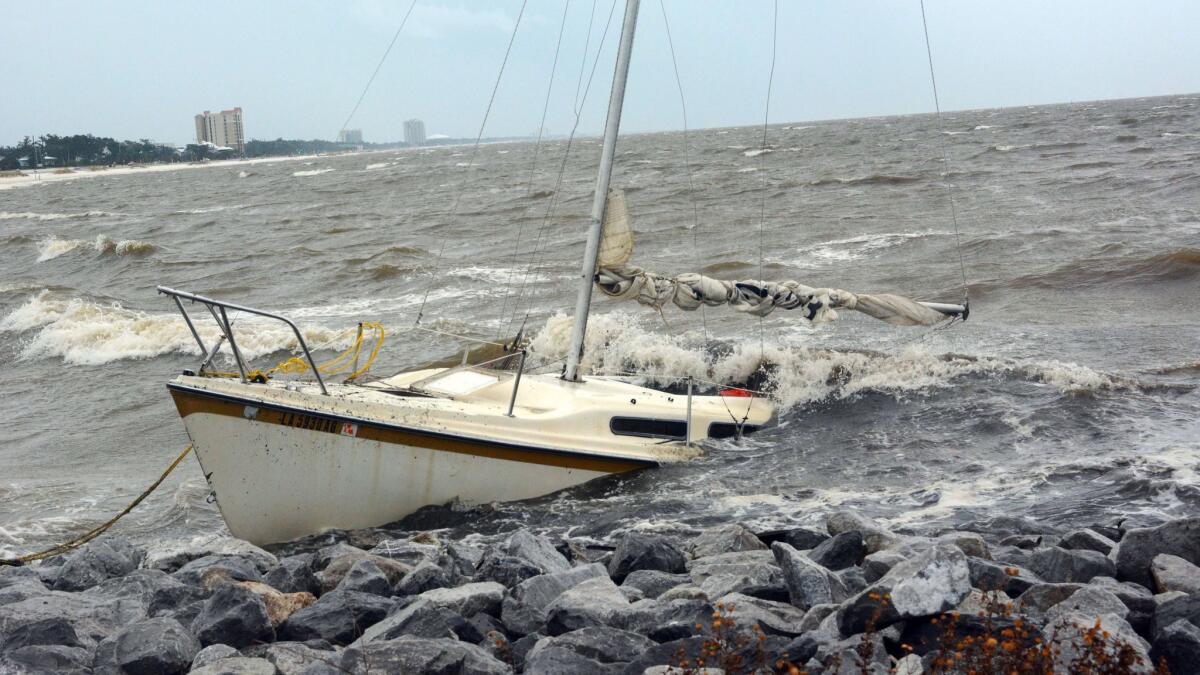Hurricane Nate makes landfall at mouth of Mississippi River
- Share via
Reporting from new orleans — Hurricane Nate came ashore at the mouth of the Mississippi River on Saturday and pelted the central Gulf Coast with wind and rain as the fast-moving storm steamed toward the Mississippi coast, where it was expected to make another landfall and threatened to inundate homes and businesses in vulnerable low-lying areas.
Nate was expected to pass to the east of New Orleans, sparing the city its most ferocious winds and storm surge. And its quick speed decreased the likelihood of prolonged rain that would tax the city’s weakened drainage pump system.
Still, the city famous for all-night partying was placed under a curfew, effective at 7 p.m., and the streets were not nearly as crowded as they typically are on a Saturday night.
Cities along the Mississippi coast such as Gulfport and Biloxi were on high alert. Some beachfront hotels and casinos were evacuated. Rain began falling on the region Saturday, and forecasters called for 3 to 6 inches with as much as 10 inches in places.
Nate weakened slightly and was a Category 1 storm with maximum winds of 85 mph when it made landfall in a sparsely populated area of Plaquemines Parish. Forecasters had said it was possible that it could strengthen to a Category 2, but that seemed less likely as the night wore on.
Storm surges threatened low-lying communities in southeast Louisiana, eastward to the Alabama fishing village of Bayou la Batre.
“If it floods again, this will be it. I can’t live on promises,” said Larry Bertron as said as he and his wife prepared to leave their home in the Braithwaite community of vulnerable Plaquemines Parish. The hurricane veterans lost a home to Hurricane Katrina in 2005 and were leaving the house they rebuilt after Hurricane Isaac in 2012.
Governors in Louisiana, Mississippi and Alabama declared states of emergency. The three states have been mostly spared during this hectic hurricane season.
“This is the worst hurricane that has impacted Mississippi since Hurricane Katrina,” Mississippi Emergency Management Director Lee Smithson said Saturday. “Everyone needs to understand that — that this is a significantly dangerous situation.”
Louisiana Gov. John Bel Edwards urged residents to make final preparations quickly and stressed that Nate would bring the possibility of storm surge reaching up to 11 feet in some coastal areas.
“It’s going to hit and move through our area at a relatively fast rate, limiting the amount of time it’s going to drop rain,” the Democratic governor said. “But this is a very dangerous storm nonetheless.”

Streets in low-lying areas of Louisiana were already flooded. Places outside levee protections were under mandatory evacuation orders and shelters had opened.
Some people worried about New Orleans’ pumping system, which had problems during a heavy thunderstorm Aug. 5. The deluge exposed system weaknesses — including the failure of some pumps and power-generating turbines — and caused homes and businesses to flood. Repairs have been made but the system remained below maximum pumping capacity.
On Alabama’s Dauphin Island, water washed over the road Saturday on the island’s low-lying west end, said Mayor Jeff Collier. Nate was projected to bring storm surges from 7 to 11 feet near the Alabama-Mississippi state line. Some of the biggest effects might be seen at the top of funnel-shaped Mobile Bay.
The window for preparing “is quickly closing,” Alabama Emergency Management Agency Director Brian Hastings said.
Florida Gov. Rick Scott warned residents of the Panhandle to prepare for Nate’s impact.
“Hurricane Nate is expected to bring life-threatening storm surges, strong winds and tornadoes that could reach across the Panhandle,” the Republican governor said. The evacuations affect roughly 100,000 residents in the western Panhandle.
Pensacola International Airport announced it was closing at 6 p.m. Saturday and would remain closed Sunday. However, Louis Armstrong New Orleans International Airport was open Saturday.
“We are urging customers to check with their specific airlines to see whether their flights have been canceled, because there have been some of those,” spokeswoman Michelle Wilcut said.
Nate is expected to quickly weaken as it cuts a path through the Southeast on its way to the Mid-Atlantic and Northeastern U.S., which could see its effects early next week.
The storm killed at least 21 people as it strafed Central America.
Waterside sections of New Orleans, outside the city’s levee system, were under an evacuation order. About 2,000 people were affected. But not everyone was complying.
Gabriel Black stayed behind because an 81-year-old neighbor refused to leave.
“I know it sounds insane, but he has bad legs and he doesn’t have anybody who can get to him,” Black said.
Ahead of Saturday night’s curfew, some bars were closed in the French Quarter, but music blasted from others.
“We’re down here from Philly and we’re not going to just stay in our hotel room,” said Kelly Howell, who was with friends at the Bourbon Street Drinker.
ALSO
U.S. payrolls shrink for first time in 7 years: Hurricanes walloped job growth
Thousands of Puerto Ricans land in Florida, fleeing the misery left by Hurricane Maria
UPDATES:
6:35 p.m.: This article was updated after Nate made landfall.
6 p.m.: Updated with storm hitting the coast and new details throughout.
8:30 a.m.: Updated with Nate expected to be a Category 2 hurricane at landfall.
5:40 a.m.: Updated to raise wind speed from 80 to 85 mph.
This article was first published at 1 a.m.
More to Read
Sign up for Essential California
The most important California stories and recommendations in your inbox every morning.
You may occasionally receive promotional content from the Los Angeles Times.









